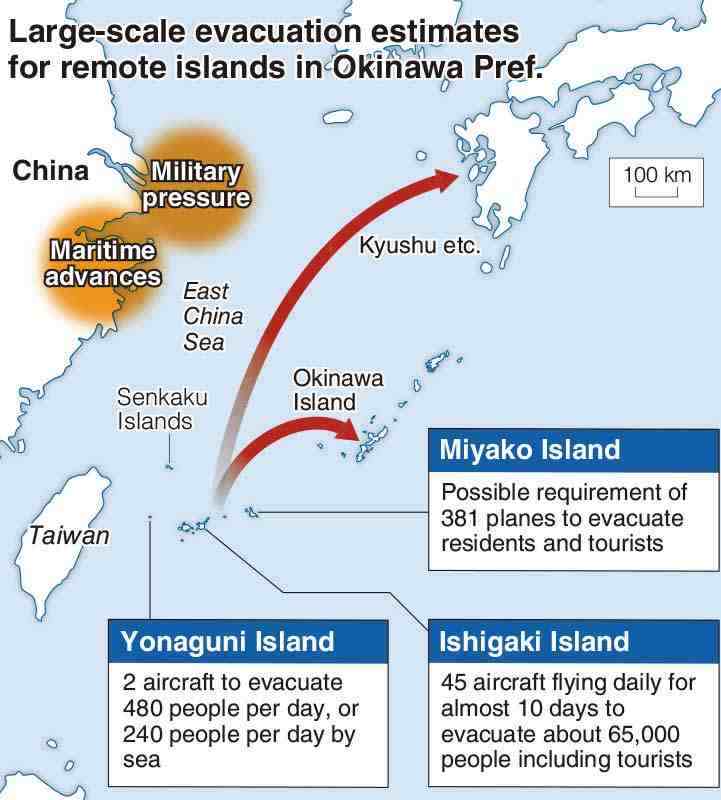Lessons from Ukraine / Evacuation plans for remote islands, urban areas lack feasibility

6:00 JST, September 4, 2022
Six months have passed since Russia invaded Ukraine. Since the conflict began, new modes of war and related defense issues have come to light. This is the final installment of a series on possible lessons for Japan.
Draft evacuation guidelines devised by the Yonaguni local government on Yonaguni Island, Okinawa Prefecture, outline evacuation methods and policies covering several scenarios based on the Civil Protection Law.
For example: “At 7:10 a.m. on Friday DD/MM/YYYY, there were signs of a ballistic missile launch by Country H. The missile will hit in about 10 minutes. It is difficult to identify the target of the attack,” and “On DD/MM/YYYY, an armed attack by Country N is expected. There is a possibility of a landing from the air or sea. A lengthy evacuation may also be possible.”
On Yonaguni, Japan’s westernmost island, there are no plans to build shelters because of the costs involved and other factors. Instead, caves that people hid in during the Battle of Okinawa are expected to be used in the event of an emergency.
The municipality is checking the current state of the caves, as the natural shelters are only expected to be used as temporary protection.
However, if residents were given a warning of an incoming strike 10 minutes in advance, it would be extremely difficult to get to the shelters. “The realistic option is to stay indoors, away from the windows,” a town official said.
It would also be challenging to gain the understanding of the approximately 1,700 islanders in the event of a prolonged evacuation if there was a threat of an enemy landing.
With Taiwan facing the threat of invasion by China, Yonaguni’s municipal government has begun the process of updating its evacuation guidelines as the island is only about 110 kilometers from Taiwan.
In response to a visit to Taiwan by U.S. House Speaker Nancy Pelosi, the Chinese military conducted exercises in the seas and airspace surrounding Taiwan from Aug. 4. Five Chinese ballistic missiles landed in Japan’s exclusive economic zones (EEZ) for the first time.
A missile landed in waters about 80 kilometers north-northwest of Yonaguni Island, where the local government received inquiries from residents seeking information about shelters in the event of an emergency.
In the event of a conflict erupting in Taiwan, a situation in which China’s first offensive involves missiles raining down in the region has become a reality.
The evacuation of islanders is not an issue for Yonaguni alone.
According to estimates based on the Civil Protection Law, Miyako Island will require 381 commercial aircraft to evacuate residents and about 3,000 tourists. In the case of Ishigaki Island, even if 45 planes were operated a day, it would take just under 10 days to evacuate about 65,000 residents and tourists.
The central government estimates that it would take two to three weeks to evacuate people from the Sakishima Isles and surrounding areas, including the islands of Yonaguni, Miyako and Ishigaki.
Also being considered is a plan to transport the evacuees in stages: first transporting them to Okinawa Island and then to Kyushu and elsewhere.
However, there is no guarantee that sufficient transportation capacity can be secured because the sea around the island could be blockaded in the event of an emergency in Taiwan.
“We have not even decided where to evacuate the islanders. The central government lacks a sense of crisis,” said Yonaguni Mayor Kenichi Itokazu.
Underground passages
In May, the Tokyo metropolitan government designated four underground passageways as evacuation locations, in addition to 55 Toei Subway and 50 Tokyo Metro stations.
The newly designated evacuation locations include One Day Street, a 430-meter passageway leading from Shinjuku Station to the skyscraper district and the Tokyo Metropolitan Government Office, and the 300-meter Season Road, a branch of the same underground passage.
“The invasion of Ukraine has finally prompted the Tokyo metropolitan government to act,” a senior central government official said.
In Ukraine, underground shelters built in the Soviet era in anticipation of a nuclear attack helped to reduce casualties during the Russian invasion.
Japan has designated 94,000 locations as evacuation facilities under the Civil Protection Law, but only 1,300 of them are underground, less than 2% of the total.
The government is in a hurry to designate more underground facilities.
Challenges also remain for the evacuation plans of cities such as Tokyo and Osaka.
In the event of an emergency, people are likely to seek shelter in subways and underground passageways, with a high possibility of panic erupting amid the chaos.
The specific operation of evacuation plans, such as securing evacuation routes and stockpiling food and water, has been left up to local governments. But in reality, little progress has been made.
In Taiwan, which faces the threat of armed aggression, a system has been introduced whereby people can receive an alert via their smartphones and find the location of nearby shelters via an app.
More than 100,000 locations have been registered, including building basements and subway stations, that can accommodate about 87 million people, much higher than Taiwan’s population of about 23 million.
Large-scale evacuation drills are also held once a year to help residents develop their ability to make decisions and protect themselves. In Japan, evacuation drills based on scenarios like a Taiwan emergency are rarely held and public awareness is low.
“The invasion of Ukraine has made the Japanese people aware of the possibility that any country can be invaded,” said Nihon University Prof. Mitsuru Fukuda. “An emergency in Taiwan is an imminent threat, and the government must move ahead with concrete preparations, such as designating evacuation sites.”
As the only country to have suffered a nuclear attack in a war, Japan has continued to emphasize the horrors of nuclear weapons, but this alone will not guarantee that the country will never again be subjected to a nuclear attack.
Japan must address the severe security environment and prepare for unexpected situations.





